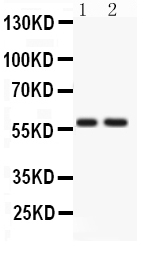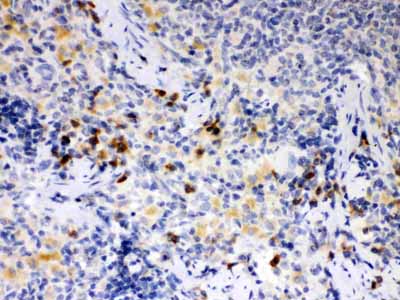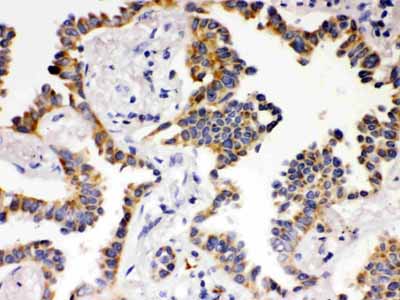Anti-ATG14L Picoband Antibody
- SPECIFICATION
- CITATIONS
- PROTOCOLS
- BACKGROUND

Application
| WB, IHC-P |
|---|---|
| Primary Accession | Q6ZNE5 |
| Host | Rabbit |
| Reactivity | Human, Rat |
| Clonality | Polyclonal |
| Format | Lyophilized |
| Description | Rabbit IgG polyclonal antibody for Beclin 1-associated autophagy-related key regulator (ATG14) detection. Tested with WB, IHC-P in Human;Rat. |
| Reconstitution | Add 0.2ml of distilled water will yield a concentration of 500ug/ml. |
| Gene ID | 22863 |
|---|---|
| Other Names | Beclin 1-associated autophagy-related key regulator, Barkor, Autophagy-related protein 14-like protein, Atg14L, ATG14 {ECO:0000303|PubMed:18843052} |
| Calculated MW | 55309 MW KDa |
| Application Details | Immunohistochemistry(Paraffin-embedded Section), 0.5-1 µg/ml, Human, Rat, By Heat Western blot, 0.1-0.5 µg/ml, Human, Rat |
| Subcellular Localization | Cytoplasm . Endoplasmic reticulum membrane ; Peripheral membrane protein . Preautophagosomal structure membrane ; Peripheral membrane protein . Cytoplasmic vesicle, autophagosome membrane ; Peripheral membrane protein . Cytosolic under nutrient-rich conditions (PubMed:19050071). Following autophagy stimuli, such as starvation or rapamycin induction, predominantly detected in cytoplasmic foci, identified as isolation membranes and autophagosomes (PubMed:19050071). Accumulates on highly curved PtdIns(3)P enriched autophagic membrane via its BATS domain to sense and maintain membrane curvature (By similarity). Localizes also to discrete punctae along the ciliary axoneme and to the base of the ciliary axoneme (By similarity). . |
| Protein Name | Beclin 1-associated autophagy-related key regulator |
| Contents | Each vial contains 5mg BSA, 0.9mg NaCl, 0.2mg Na2HPO4, 0.05mg NaN3. |
| Immunogen | A synthetic peptide corresponding to a sequence at the N-terminus of human ATG14L (70-101aa RDRERFIDKKERLSRLKSKQEEFQKEVLKAME), different from the related mouse and rat sequences by two amino acids. |
| Purification | Immunogen affinity purified. |
| Cross Reactivity | No cross reactivity with other proteins |
| Storage | At -20˚C for one year. After r˚Constitution, at 4˚C for one month. It˚Can also be aliquotted and stored frozen at -20˚C for a longer time.Avoid repeated freezing and thawing. |
| Sequence Similarities | Belongs to the ATG14 family. |
| Name | ATG14 {ECO:0000303|PubMed:18843052} |
|---|---|
| Function | Required for both basal and inducible autophagy. Determines the localization of the autophagy-specific PI3-kinase complex PI3KC3-C1 (PubMed:18843052, PubMed:19050071). Plays a role in autophagosome formation and MAP1LC3/LC3 conjugation to phosphatidylethanolamine (PubMed:19270696, PubMed:20713597). Promotes BECN1 translocation from the trans-Golgi network to autophagosomes (PubMed:20713597). Enhances PIK3C3 activity in a BECN1-dependent manner. Essential for the autophagy-dependent phosphorylation of BECN1 (PubMed:23878393). Stimulates the phosphorylation of BECN1, but suppresses the phosphorylation PIK3C3 by AMPK (PubMed:23878393). Binds to STX17-SNAP29 binary t-SNARE complex on autophagosomes and primes it for VAMP8 interaction to promote autophagosome-endolysosome fusion (PubMed:25686604, PubMed:37632749). Modulates the hepatic lipid metabolism (By similarity). |
| Cellular Location | Cytoplasm. Endoplasmic reticulum membrane; Peripheral membrane protein. Preautophagosomal structure membrane; Peripheral membrane protein. Cytoplasmic vesicle, autophagosome membrane; Peripheral membrane protein. Note=Cytosolic under nutrient-rich conditions (PubMed:19050071). Following autophagy stimuli, such as starvation or rapamycin induction, predominantly detected in cytoplasmic foci, identified as isolation membranes and autophagosomes (PubMed:19050071). Accumulates on highly curved PtdIns(3)P enriched autophagic membrane via its BATS domain to sense and maintain membrane curvature (By similarity). Localizes also to discrete punctae along the ciliary axoneme and to the base of the ciliary axoneme (By similarity). {ECO:0000250|UniProtKB:Q8CDJ3} |

Thousands of laboratories across the world have published research that depended on the performance of antibodies from Abcepta to advance their research. Check out links to articles that cite our products in major peer-reviewed journals, organized by research category.
info@abcepta.com, and receive a free "I Love Antibodies" mug.
Provided below are standard protocols that you may find useful for product applications.
Background
ATG14 (also known as beclin-1-associated autophagy-related key regulator (Barkor) or ATG14L), an essential autophagy-specific regulator of the class III phosphatidylinositol 3-kinase complex, promotes membrane tethering of protein-free liposomes, and enhances hemifusion and full fusion of proteoliposomes reconstituted with the target (t)-SNAREs (soluble N-ethylmaleimide-sensitive factor attachment protein receptors) syntaxin 17 (STX17) and SNAP29, and the vesicle (v)-SNARE VAMP8 (vesicle-associated membrane protein 8). ATG14 binds to the SNARE core domain of STX17 through its coiled-coil domain, and stabilizes the STX17-SNAP29 binary t-SNARE complex on autophagosomes.
If you have used an Abcepta product and would like to share how it has performed, please click on the "Submit Review" button and provide the requested information. Our staff will examine and post your review and contact you if needed.
If you have any additional inquiries please email technical services at tech@abcepta.com.













 Foundational characteristics of cancer include proliferation, angiogenesis, migration, evasion of apoptosis, and cellular immortality. Find key markers for these cellular processes and antibodies to detect them.
Foundational characteristics of cancer include proliferation, angiogenesis, migration, evasion of apoptosis, and cellular immortality. Find key markers for these cellular processes and antibodies to detect them. The SUMOplot™ Analysis Program predicts and scores sumoylation sites in your protein. SUMOylation is a post-translational modification involved in various cellular processes, such as nuclear-cytosolic transport, transcriptional regulation, apoptosis, protein stability, response to stress, and progression through the cell cycle.
The SUMOplot™ Analysis Program predicts and scores sumoylation sites in your protein. SUMOylation is a post-translational modification involved in various cellular processes, such as nuclear-cytosolic transport, transcriptional regulation, apoptosis, protein stability, response to stress, and progression through the cell cycle. The Autophagy Receptor Motif Plotter predicts and scores autophagy receptor binding sites in your protein. Identifying proteins connected to this pathway is critical to understanding the role of autophagy in physiological as well as pathological processes such as development, differentiation, neurodegenerative diseases, stress, infection, and cancer.
The Autophagy Receptor Motif Plotter predicts and scores autophagy receptor binding sites in your protein. Identifying proteins connected to this pathway is critical to understanding the role of autophagy in physiological as well as pathological processes such as development, differentiation, neurodegenerative diseases, stress, infection, and cancer.




